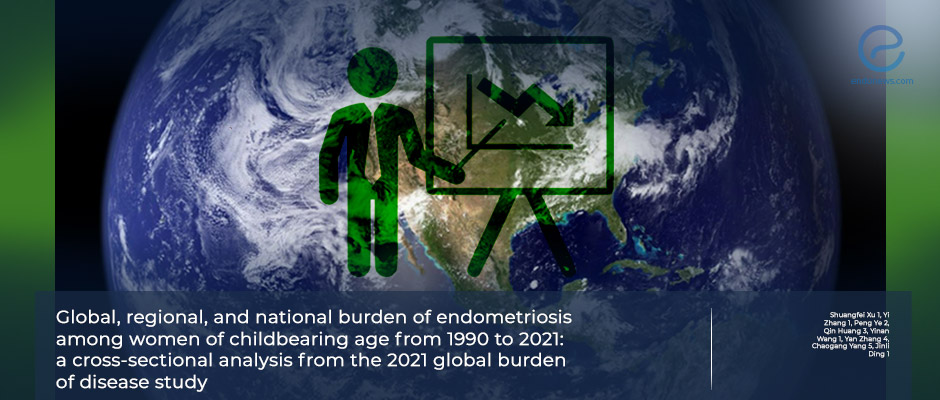New Study Analyzes Burden of Endometriosis
Aug 26, 2025
Endometriosis burden is in decline, but there are still disparities that need to be addressed.
Key Points
Highlights:
- Endometriosis continues to pose a major global health burden, despite a gradual decline in prevalence since 1991.
- Marked sociodemographic disparities persist, with women in lowersociodemographic indwex regions carrying the heaviest disease burden.
Importance:
- These findings emphasize the urgent need for targeted policies, improved surveillance, and preventive strategies to reduce the global impact of endometriosis.
What’s done here:
- Data from the Global Burden of Disease 2021 was analyzed to estimate global prevalence, incidence, and disability-adjusted life-years associated with endometriosis.
- A cross-sectional approach was used, with age-standardized rates calculated across regions and time.
Key results:
- In 2021, there were 22.28 million women affected by endometriosis, corresponding to an age-standardized prevalence rate of 1023.8 per 100,000.
- Women aged 25–29 years were most affected.
- Low sociodemographic index regions showed the highest prevalence, incidence, and disability-adjusted life-years.
- Oceania and Eastern Europe had the highest age-standardized prevalence and disability-adjusted life-years, while the Solomon Islands reported the highest incidence.
- The global age-standardized prevalence is projected to decline by 13.3% by 2040, reaching 887.9 per 100,000.
Limitations:
- Estimates are constrained by diagnostic variability, inconsistent disease coding, and limited surveillance systems, leading to potential reporting bias.
- Clinical underdiagnosis and misdiagnosis of endometriosis remain major challenges.
- Risk factors were not included in GBD 2021, limiting interpretation of causative trends.
From the Editor-in-Chief – EndoNews
"This study underscores what clinicians and policymakers must never forget: endometriosis remains a major global health burden, affecting over 22 million women in 2021 alone. The modest decline in prevalence over the past three decades is encouraging, but the uneven distribution of disease—highest in low-SDI regions, Oceania, and Eastern Europe—tells a different story. Endometriosis is not merely a gynecologic disorder; it is a marker of global health inequality.
The finding that women in their most productive years (ages 25–29) carry the heaviest burden has direct implications for education, workforce participation, and fertility. Projected declines in prevalence by 2040 may look promising, but without better diagnostics, unified coding systems, and investment in surveillance, these numbers risk underestimating the true magnitude of disease.
What should we take away? Endometriosis needs to be recognized as a chronic, disabling condition with profound public health and economic consequences. Prevention and treatment policies must move beyond tertiary centers, reaching women in underserved regions where the burden is greatest. If global health strategies fail to integrate endometriosis into the agenda of non-communicable diseases, millions of women will continue to suffer in silence."
Lay Summary
The burden of endometriosis has decreased globally between 1990 and 2021, according to a new study published in the International Journal of Surgery, mainly due to population growth and epidemiologic change.
However, there are still significant disparities, especially in regions with a low sociodemographic index.
“It is necessary to develop better policies and preventive measures to effectively address the range of problems associated with endometriosis,” the auhtors of the study concluded.
To assess the prevalence, incidence, and disability-adjusted life-years of patients with endometriosis between 1990 and 2021 around the world, by country, and regionally, a team of researchers led by Dr. Jinli Ding from Reproductive Medical Center, Renmin Hospital of Wuhan University and Hubei Clinic Research center for Assisted Reproductive Technology and Embryonic Development in Wuhan, China conducted a cross-sectional analysis. They reported that the global burden of endometriosis was still “substantial” in 2021, with 22.28 million women affected by the disease.
This number corresponds to an age-standardized prevalence rate of 1023.8 per 100,000, the researchers explained.
The age-standardized incidence rates of the disease were 162.71 per 100 000 and the age-standardized disability-adjusted life-years rate was 94.25 per 100,000. When they analyzed the data on a regional basis, the authors found that the rates of age-standardized prevalence, age-standardized incidence, and age-standardized disability-adjusted life-years were highest in areas with a low sociodemographic index.
On the contrary, in regions with a high sociodemographic index, these rates were the lowest.
The researchers also found that the rates of age-standardized prevalence and disability-adjusted life-years were highest in Oceania and Eastern Europe, while the Solomon Islands had the highest age-standardized incidence rates. The most affected group was women ages 25 to 29, suggesting they should be a key focus group for interventions.
When they projected trends through 2040, they reported that the age-standardized prevalence rate is projected to decline to 887.89 per 100,000 by 2040. This, they said, corresponds to a decrease of 13.28%.
Research Source: https://pubmed.ncbi.nlm.nih.gov/40540534/
endometriosis burden incidence prevalence diagnosis

